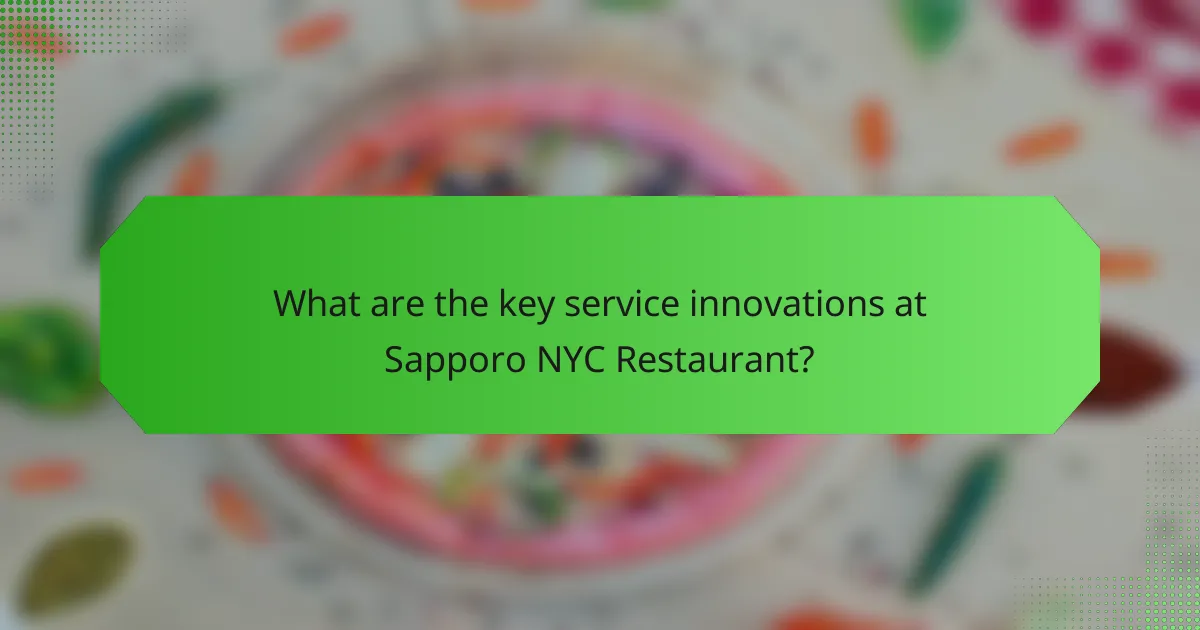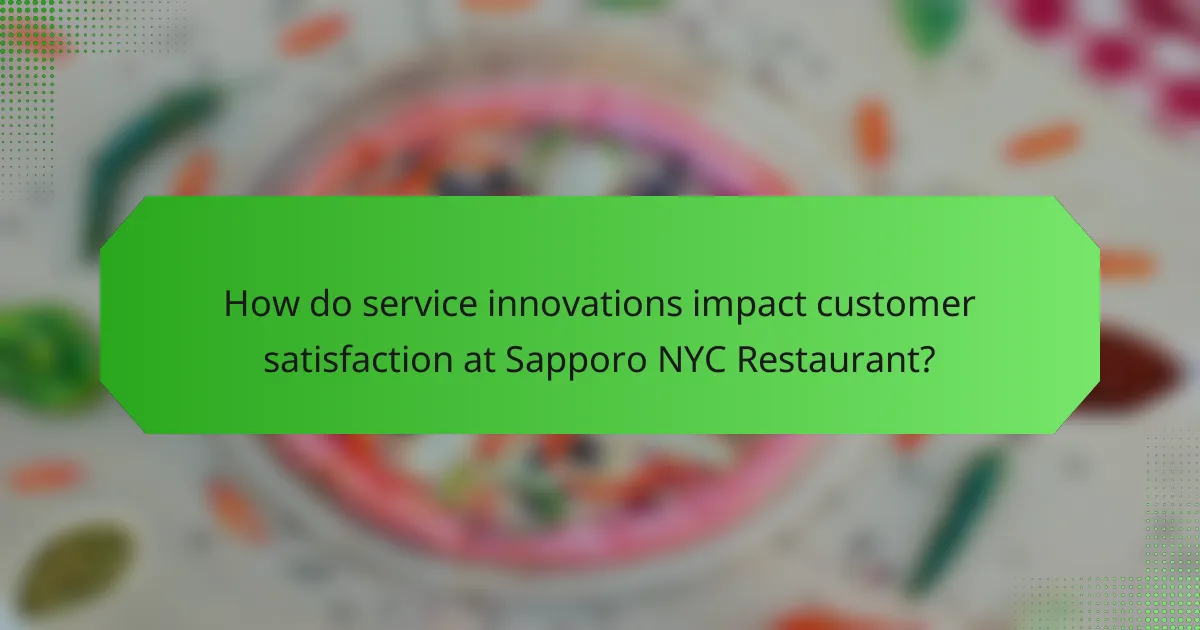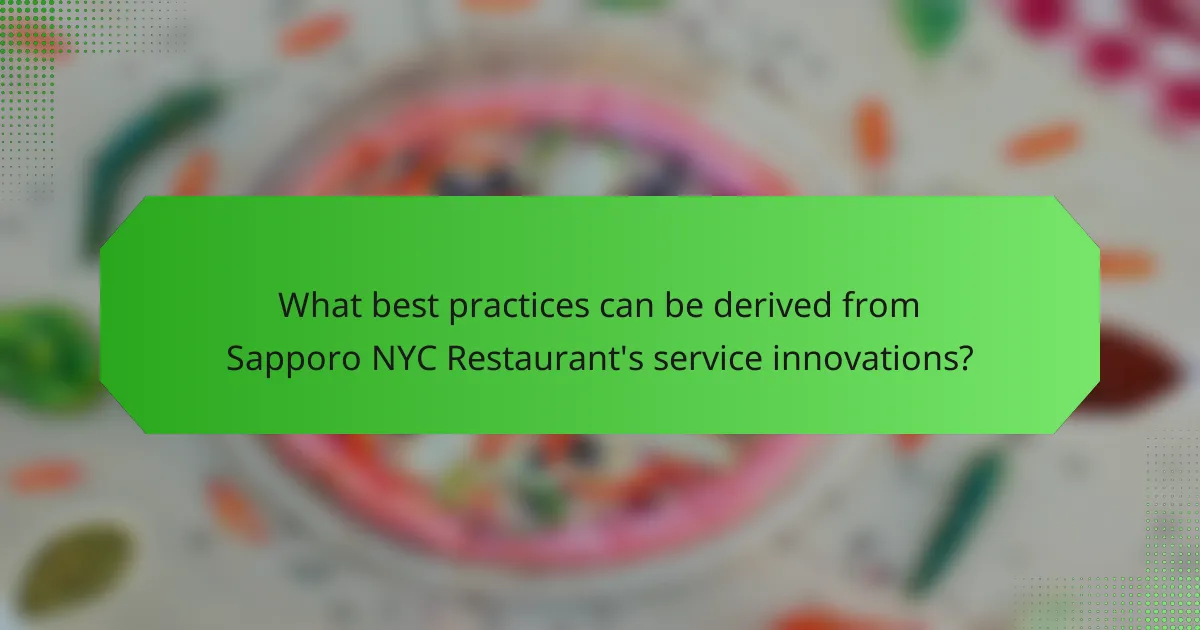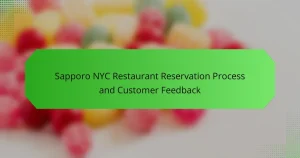
What are the key service innovations at Sapporo NYC Restaurant?
Sapporo NYC Restaurant has implemented several key service innovations. These include an interactive dining experience through tablet ordering systems. This allows customers to customize their meals and provides instant feedback. Additionally, Sapporo offers a loyalty program that rewards repeat customers with exclusive discounts. The restaurant also features an open kitchen concept, enhancing transparency and engagement. Furthermore, Sapporo has introduced online reservations and delivery services to improve convenience. These innovations contribute to a more satisfying customer experience, ultimately boosting retention rates.
How do these innovations enhance the dining experience?
Innovations in restaurant service enhance the dining experience by improving efficiency and personalization. For example, the use of digital menus allows customers to browse options at their own pace. This reduces wait times and improves decision-making. Additionally, table-side ordering systems streamline the process, enabling quicker service. Personalized recommendations based on past orders create a more tailored experience. These innovations increase customer satisfaction, leading to higher retention rates. Studies show that restaurants implementing such technologies see a 20% increase in repeat visits. Overall, these advancements create a more enjoyable and efficient dining atmosphere.
What technologies are implemented in Sapporo NYC Restaurant’s service innovations?
Sapporo NYC Restaurant implements several technologies in its service innovations. These include an advanced point-of-sale (POS) system for efficient order processing. The restaurant utilizes mobile ordering applications to enhance customer convenience. Tabletop tablets are available for customers to place orders directly. Sapporo also employs data analytics to personalize customer experiences. Contactless payment options are offered to streamline transactions. Additionally, the restaurant uses social media platforms for customer engagement and feedback. These technologies collectively improve service efficiency and customer satisfaction.
How do staff training and development contribute to service innovations?
Staff training and development significantly enhance service innovations. Training equips employees with new skills and knowledge. This empowers them to implement innovative service practices. Development fosters a culture of continuous improvement. Employees feel more confident in suggesting new ideas. A study by the American Society for Training and Development found that organizations with effective training programs see 218% higher income per employee. This correlation indicates that well-trained staff drive innovation. Enhanced service leads to improved customer satisfaction and retention.
Why is customer retention important for Sapporo NYC Restaurant?
Customer retention is crucial for Sapporo NYC Restaurant as it drives profitability and brand loyalty. Retaining existing customers is less costly than acquiring new ones. Research indicates that increasing customer retention rates by 5% can boost profits by 25% to 95%. Loyal customers also tend to spend more over time. They often become brand advocates, referring new customers through word-of-mouth. This enhances the restaurant’s reputation and attracts new clientele. Furthermore, consistent patronage allows Sapporo NYC Restaurant to better predict inventory and staffing needs, improving operational efficiency. Overall, effective customer retention strategies lead to sustainable growth and success for the restaurant.
What metrics are used to measure customer retention at Sapporo NYC Restaurant?
Sapporo NYC Restaurant measures customer retention using metrics such as repeat visit rate, customer lifetime value, and customer satisfaction scores. The repeat visit rate indicates how often customers return after their initial visit. Customer lifetime value estimates the total revenue generated from a customer over their relationship with the restaurant. Customer satisfaction scores are gathered through surveys to assess the dining experience. These metrics provide a comprehensive view of customer loyalty and help identify areas for improvement.
How does customer feedback influence service innovations?
Customer feedback significantly influences service innovations by providing insights into customer preferences and pain points. Restaurants like Sapporo NYC utilize feedback to identify areas for improvement. This feedback can lead to the development of new menu items or enhancements in service delivery. For instance, if customers express a desire for healthier options, the restaurant may innovate by introducing lighter dishes. Additionally, feedback helps prioritize changes that directly impact customer satisfaction. Studies show that businesses that actively seek and implement customer feedback see a 10-15% increase in customer retention rates. This correlation underscores the importance of listening to customers in driving effective service innovations.

How do service innovations impact customer satisfaction at Sapporo NYC Restaurant?
Service innovations at Sapporo NYC Restaurant enhance customer satisfaction by improving the dining experience. Innovations such as personalized service, advanced reservation systems, and menu customization cater to customer preferences. These enhancements lead to increased customer engagement and loyalty. Research indicates that restaurants implementing service innovations see a 20% rise in customer satisfaction ratings. Sapporo NYC Restaurant’s focus on technology and customer feedback allows for continuous improvement. This adaptability helps meet evolving customer expectations, further solidifying satisfaction levels. Overall, service innovations play a crucial role in elevating the customer experience at Sapporo NYC Restaurant.
What specific innovations have the greatest effect on customer satisfaction?
Personalized customer service innovations have the greatest effect on customer satisfaction. These include tailored recommendations based on customer preferences. Implementing advanced data analytics allows restaurants to understand customer behaviors. Technology like mobile ordering enhances convenience and reduces wait times. Additionally, loyalty programs incentivize repeat visits, fostering customer loyalty. A study by McKinsey found that personalized experiences can lead to a 10-15% increase in customer satisfaction scores. These innovations create a more engaging dining experience, ultimately improving customer retention.
How do personalized services improve customer loyalty?
Personalized services improve customer loyalty by creating tailored experiences that meet individual preferences. Customers feel valued when their specific needs and desires are acknowledged. This leads to increased satisfaction and a stronger emotional connection to the brand. Research shows that businesses offering personalized experiences can see a 20% increase in customer retention rates. Additionally, personalized recommendations can enhance cross-selling opportunities, further boosting loyalty. By addressing customers by name and remembering their previous orders, restaurants can foster a sense of familiarity. This approach encourages repeat visits and positive word-of-mouth referrals. Overall, personalized services are crucial for building lasting customer relationships in the restaurant industry.
What role do ambiance and atmosphere play in customer satisfaction?
Ambiance and atmosphere significantly influence customer satisfaction. A well-designed environment enhances the dining experience. Elements such as lighting, decor, and music contribute to the overall mood. Research shows that 70% of customers return to a restaurant due to its atmosphere. Positive ambiance can elevate perceptions of food quality. Customers often associate a pleasant atmosphere with better service. This connection leads to increased loyalty and repeat visits. Sapporo NYC exemplifies this by creating a welcoming environment that enhances customer retention.
What are the challenges faced in implementing service innovations?
Implementing service innovations in the restaurant sector faces several challenges. Resistance to change among staff can hinder the adoption of new practices. Training employees effectively on new technologies or services is often resource-intensive. Additionally, aligning innovations with customer expectations requires thorough market research. Financial constraints may limit the ability to invest in necessary tools or training. Moreover, maintaining consistent service quality during the transition can be difficult. Lastly, measuring the impact of innovations on customer retention can be complex and requires ongoing analysis.
How does Sapporo NYC Restaurant address resistance to change among staff?
Sapporo NYC Restaurant addresses resistance to change among staff through effective communication and training programs. The management ensures that staff members are informed about the reasons for changes. This transparency helps reduce uncertainty and builds trust. Additionally, Sapporo offers training sessions to equip staff with the necessary skills for new procedures. These sessions foster a sense of competence and confidence among employees. Moreover, feedback from staff is encouraged during the change process. This inclusion helps employees feel valued and heard. As a result, the restaurant experiences smoother transitions and improved staff morale.
What are the financial implications of adopting new service innovations?
Adopting new service innovations can significantly impact financial performance. These innovations often lead to increased operational efficiency, reducing costs in the long run. For example, implementing technology such as online ordering systems can decrease labor costs and enhance customer experience. Additionally, service innovations can attract new customers, leading to higher sales revenue. A study by McKinsey found that companies that innovate in service delivery can see revenue increases of up to 30%. Furthermore, improved customer satisfaction from innovative services can enhance customer loyalty, resulting in repeat business. This repeat business is crucial, as acquiring a new customer can cost five times more than retaining an existing one. Therefore, the financial implications of adopting new service innovations are predominantly positive, driving both cost savings and revenue growth.

What best practices can be derived from Sapporo NYC Restaurant’s service innovations?
Sapporo NYC Restaurant’s service innovations highlight several best practices. One key practice is personalized customer service. This approach enhances customer satisfaction and loyalty. Another best practice is the integration of technology for efficient order management. This reduces wait times and improves the dining experience. Training staff to deliver consistent service is also essential. Consistency builds trust and encourages repeat visits. Additionally, soliciting customer feedback regularly helps refine service offerings. This practice ensures that the restaurant meets evolving customer preferences. Implementing these best practices can significantly boost customer retention.
How can other restaurants learn from Sapporo NYC Restaurant’s approach?
Other restaurants can learn from Sapporo NYC Restaurant’s approach by implementing personalized customer service. Sapporo focuses on building relationships with patrons through attentive staff interactions. This strategy enhances customer satisfaction and loyalty. Additionally, Sapporo offers a unique menu that highlights authentic Japanese cuisine. This differentiation attracts a niche market. Other restaurants can adopt similar strategies by emphasizing quality and authenticity in their offerings. Sapporo also utilizes feedback mechanisms to improve service continuously. Gathering customer insights helps in refining the dining experience. These practices contribute to higher customer retention rates.
What strategies can enhance the effectiveness of service innovations?
Implementing customer feedback mechanisms enhances the effectiveness of service innovations. This allows restaurants to gather insights directly from patrons. By analyzing feedback, Sapporo NYC can identify areas for improvement. Another strategy is to train staff on new service methods. Well-trained employees can deliver innovations effectively. Additionally, integrating technology can streamline service processes. For instance, using mobile ordering can reduce wait times and improve customer satisfaction. Finally, promoting service innovations through marketing can attract new customers. This approach increases awareness and encourages trial. Each of these strategies contributes to a more effective implementation of service innovations in the restaurant industry.
How can continuous improvement be fostered in restaurant service?
Continuous improvement in restaurant service can be fostered through regular staff training and feedback mechanisms. Implementing ongoing training programs enhances employee skills and service quality. Feedback from customers allows restaurants to identify areas needing improvement. Utilizing customer surveys can provide valuable insights into service experiences. Establishing a culture of open communication encourages staff to share ideas for improvement. Regular performance evaluations help maintain high service standards. Monitoring industry trends can inspire innovative service practices. Adopting technology, such as reservation systems, can streamline operations and enhance customer satisfaction.
Sapporo NYC Restaurant is the primary entity discussed in this article, focusing on its service innovations and their impact on customer retention. Key innovations include interactive dining through tablet ordering systems, a loyalty program, an open kitchen concept, and online reservations. The article explores how these innovations enhance customer satisfaction by improving efficiency, personalization, and engagement. It also examines the role of staff training, customer feedback, and the financial implications of adopting new technologies, ultimately highlighting best practices for enhancing customer loyalty and retention in the restaurant industry.


